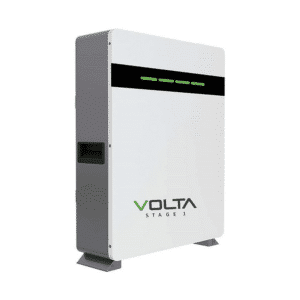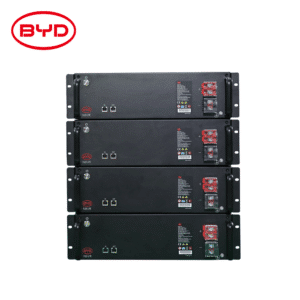Everything You Need to Know On How Much is a Solar Battery
How much is a solar battery? In this blog post, we will explore the cost of solar batteries and provide valuable insights for those looking to invest in this sustainable energy storage solution. Whether you are a homeowner, business owner, or simply curious about renewable energy options, understanding the pricing of solar batteries for sale is crucial. Let’s delve into the details and uncover all the price factors that influence the cost of a solar battery.
How Much is a Solar Battery?
Solar batteries are essential to renewable energy systems that help store and use energy more efficiently. The sun’s energy powers them and can store any excess energy solar panels generate for later use. The cost of solar batteries ranges from ZAR 20,000 to ZAR 100,000, depending on their brand and capacity.
Solar batteries are crucial to solar solution energy systems as they capture and store energy for immediate or future consumption.
Solar Battery Price Factor
A range of factors affect the cost of solar batteries. This section aims to break down these factors, providing readers with a clear comprehension of what drives the cost of solar batteries and how to evaluate their value.
Capacity and Power Ratings
Solar batteries have two necessary specifications: capacity and power rating. Capacity, measured in kilowatt-hours (kWh), refers to the amount of energy a solar battery can store. A higher capacity means that the battery can supply energy for a more extended period before recharging. However, it’s important to note that a higher capacity also means a higher cost.
On the other hand, power rating is measured in kilowatts (kW) and indicates how quickly a battery can deliver energy. Batteries with higher power ratings are more expensive but can deliver more energy at any moment. This is useful for running multiple appliances or high-demand devices simultaneously. However, it’s essential to remember that a high power rating doesn’t necessarily mean a longer-lasting battery.
When choosing a solar battery, finding the right balance between capacity and power ratings based on your energy consumption patterns is important. The most cost-effective option is not necessarily the one with the highest capacity or power rating but the one that best aligns with your energy usage needs. A battery with a high capacity but a lower power rating is suitable for prolonged energy use. In contrast, one with a high power rating but moderate capacity is ideal for short periods of high energy demand.
Depth of Discharge
Depth of Discharge (DoD) is a crucial concept for solar batteries. It refers to the percentage of the battery’s capacity that has been used. Proper management of DoD is essential to enhance a solar battery’s lifespan, operational efficiency, and cost-effectiveness.
The lifespan of a solar battery is linked to its DoD. Batteries are designed for a specific number of charge-discharge cycles, and a lower DoD can significantly extend this number. If the battery is not depleted entirely before recharging, it can last longer, allowing for more cycles. For instance, a battery regularly discharged to 50% of its capacity will generally last longer than one frequently depleted to 80%.
Operational efficiency is also affected by the DoD. Batteries tend to operate more efficiently within a specific range of discharge. Exceeding this range can lead to unnecessary energy loss, meaning that not all stored energy is effectively used. This inefficiency can translate into increased operational costs as more energy is consumed to achieve the desired output.
Understanding and adhering to the recommended DoD can significantly enhance the cost-effectiveness of a solar battery system. Ensuring that the battery operates within its optimal discharge range can minimise the need for premature battery replacements and reduce maintenance costs. This approach ensures that the stored energy is used most efficiently, maximising the battery’s utility and minimising long-term expenses.
Managing the Depth of Discharge is crucial to maintaining a solar battery. It is about protecting the battery’s lifespan and ensuring that the system operates efficiently and remains cost-effective over time. By carefully considering and adhering to the DoD recommendations, users can significantly improve the performance and longevity of their solar batteries, making them a more reliable and economical choice for energy storage.
Round Trip Efficiency
Round Trip Efficiency is a crucial metric that plays a fundamental role in evaluating a solar battery’s performance and cost-effectiveness. This metric measures the proportion of energy usable after storage about the energy initially stored. Its importance is multifaceted, impacting various aspects of a solar battery’s functionality.
Firstly, round trip efficiency indicates a battery’s ability to use energy effectively. A higher value in this metric means that a more significant portion of the stored energy is available, highlighting the battery’s proficiency in storing and discharging energy. This efficiency is crucial, especially in solar energy systems where maximising the use of generated energy is critical.
Moreover, when comparing the performance of different batteries, Round Trip Efficiency serves as an essential benchmark. Batteries with higher Round Trip Efficiency are generally preferred as they signify lower energy loss during the charge-discharge cycle. This efficiency ensures that the energy harnessed from solar panels is utilised to its maximum potential, minimising wastage and enhancing the overall system’s performance.
The significance of this metric extends to the cost-effectiveness of a solar battery. Higher Round Trip Efficiency translates into more usable electricity output from the input energy, optimising the return on investment in solar technology. In an era where energy efficiency directly correlates with cost savings, ensuring minimal energy loss in storage and retrieval processes is paramount.
Furthermore, understanding a battery’s Round Trip Efficiency is vital when sizing a solar energy system. Accurate knowledge of this efficiency ensures the system is neither under nor oversized, aligning it perfectly with energy demands. It ensures that the investment in battery capacity is justified, avoiding unnecessary expenditure on excess capacity that may not be utilised.
Round Trip Efficiency is more than just a number; it’s a significant indicator of a solar battery’s ability to efficiently convert and utilise stored energy. It impacts the battery’s performance, economic viability, and the sizing of the entire solar energy system. A high Round Trip Efficiency indicates a battery that performs well and contributes to the overall cost-effectiveness of the solar energy setup.
Warranty and Lifespan
Warranty and lifespan are pivotal factors that provide insights into a solar battery’s quality and long-term value. A warranty is a manufacturer’s promise to repair or replace the battery if it fails within a certain period or under specific conditions, directly reflecting the manufacturer’s confidence in its product. On the other hand, the lifespan indicates the expected duration the battery will operate effectively, usually defined by the number of charge-discharge cycles it can undergo before its capacity significantly degrades.
When interpreting warranties, consider both the length of the warranty and what it covers. More extended warranties often signal that the manufacturer expects the battery to last longer and perform better. However, reading the fine print to understand the terms is crucial, as some warranties may only cover certain types of failures or degradation beyond a specific point.
The stated lifespan of a battery, often noted in terms of years or charge cycles, estimates how long the battery will function before its performance drops below a specific efficiency level. A battery with a longer lifespan will generally offer more value in the long run, as it won’t need to be replaced as quickly. However, the lifespan can vary based on several factors, including usage patterns, the battery’s technology, and environmental conditions.
A robust warranty and a long lifespan are indicators of a quality solar battery, suggesting reliability and cost-effectiveness over time. When evaluating these aspects, it’s essential to consider your specific needs and how the battery’s warranty and lifespan align with those needs. A comprehensive understanding of these factors will guide you in choosing a solar battery that promises optimal performance and enduring value.
A Breakdown of How much do Solar Batteries Cost
Understanding the financial aspect of investing in a solar battery is crucial. This section will provide a detailed breakdown of the costs associated with solar batteries, encompassing the initial investment, installation, and ongoing maintenance.
Initial Investment
The initial investment in a solar battery encompasses several components, primarily the purchase price, which can vary significantly based on the type and brand of the battery. This variance in cost is influenced by factors such as the technology used in the battery, its capacity, power rating, and the manufacturer’s brand reputation.
Different types of batteries, like lead-acid, lithium-ion, and saltwater, come with distinct price tags. For instance, lithium-ion batteries are typically more expensive than lead-acid batteries but offer advantages such as higher energy density, longer lifespan, and lower maintenance. This means that while the upfront cost is higher, the long-term value could justify the initial investment.
The battery brand also plays a crucial role in determining the purchase price. Established brands with proven track records in performance and reliability might charge a premium for their products. This premium often covers not just the product itself but also the customer service, warranty terms, and the peace of mind that comes with a reputable brand.
When analysing the upfront costs, it’s essential to consider these factors in the context of your specific needs and the long-term value you expect from the battery. While a cheaper option might seem attractive initially, it’s crucial to assess the total cost of ownership, including the purchase price and factors like lifespan, maintenance costs, and the potential need for early replacement. A comprehensive understanding of these aspects will enable you to make an informed decision, ensuring that your initial investment aligns with your energy needs and long-term financial planning.
Installation Costs
Installation costs for solar batteries represent a significant portion of the overall investment and are subject to variation based on various factors. Primarily, these costs encompass labour expenses, additional components such as inverters, battery management systems, and wiring, and the potential need to modify existing electrical systems to integrate the new battery.
The complexity of the installation is a primary driver of costs. Systems that demand extensive wiring, additional components, or significant alterations to the electrical infrastructure tend to incur higher labour costs. The rates for professional installation services can also vary geographically, influenced by the local demand for skilled technicians. In regions where such expertise is in high demand, the labour cost may be higher.
Furthermore, the size and type of the battery play a crucial role in determining installation expenses. Larger batteries, or those with specific handling or installation requirements—whether due to technological complexities or safety protocols—can augment the cost. Additionally, compliance with local regulations may necessitate permits or inspections, further adding to the financial outlay.
Lastly, the physical location of the installation can influence costs. Installations in areas that are difficult to access or those requiring additional measures, such as weatherproofing for outdoor setups or extra safety precautions, can lead to increased expenses.
To navigate these complexities, seeking a detailed quote from a reputable installer that covers all potential costs is advisable. This approach ensures a comprehensive understanding of the total investment required for the solar battery installation, helping to mitigate the risk of unforeseen expenses during the process.
Maintenance and Operating Costs
Maintenance and operating costs are essential considerations for the long-term management of solar batteries, impacting the overall cost-effectiveness of the solar energy system. Generally, solar batteries require minimal maintenance, but certain ongoing costs can arise, which are influenced by the type of battery, usage patterns, and the specific setup of the solar energy system.
Regular Maintenance: Some battery types, like lead-acid batteries, require regular maintenance, such as checking fluid levels and cleaning terminals to ensure optimal performance. Although maintenance requirements for lithium-ion batteries are typically lower, periodic inspections are recommended to ensure the system functions correctly.
Battery Replacement: Even with proper maintenance, batteries have a finite lifespan and eventually need replacement. The replacement frequency depends on the battery type, the number of charge-discharge cycles it undergoes, and how deeply it’s typically discharged (Depth of Discharge).
Energy Efficiency Losses: Batteries may experience decreased efficiency over time, meaning they store and deliver less energy than when they were new. This efficiency loss can lead to increased operational costs, as the system may need to draw more power from the grid if the stored energy is insufficient.
System Monitoring and Management: Advanced solar battery systems often require monitoring and management tools to optimise performance. While these systems can enhance efficiency and longevity, they entail additional costs, including software updates and potential subscription fees for monitoring services.
Warranty and Service Contracts: Some manufacturers offer extended warranties or service contracts for an additional fee. These can provide peace of mind and protect against unexpected repair costs but add to the overall cost of ownership.
Understanding these ongoing costs is vital for a realistic assessment of the total cost of ownership of a solar battery system. While solar batteries generally offer the advantage of low maintenance and operation costs, considering these potential expenses will provide a more accurate picture of the long-term investment and help ensure a cost-effective and efficient solar energy solution.
Conclusion
In conclusion, the price of a solar battery can vary significantly depending on various factors such as capacity, brand, and installation costs. While the upfront cost of purchasing a solar battery may seem high, it is essential to consider the long-term benefits and potential savings it can provide regarding reduced energy bills and increased energy independence. The cost of owning a solar battery over its lifespan should also be considered, including maintenance and replacement expenses. Despite the initial investment, investing in a solar battery can be a valuable and sustainable choice for individuals seeking to harness clean and renewable energy for their power needs.






